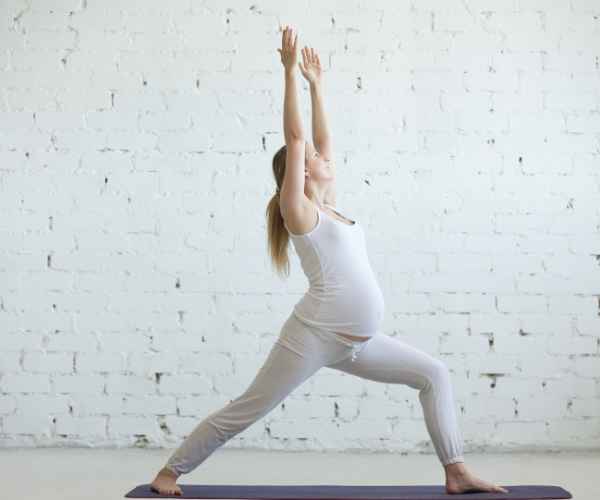Prenatal yoga is that shot that every woman badly requires on the mental, spiritual and physical level during their pregnancy. As the body starts to change rapidly, using yoga can be one way to remain fit, enhance flexibility as well as developing a bond with the baby. One of the praying benefits of incorporating such factors is the ability to continuously grow with the pregnancy on a physical level. It is these advantages and many others that make this yoga especially useful during the pregnancy phase as are around 5 advantages I want to discuss with you today.
But be patient, breath in before we get there, let’s zoom in on the specific details of this yoga and the benefits it can provide at each stage of pregnancy including easing the pregnancy complications.

Key Features Of Prenatal Yoga
So according to the name, prenatal yoga is specifically for women who are pregnant, the reason for that is it takes into account what you are going through, more specifically the changes your body is undergoing. You can say, this type is for those who require something gentle throughout the struggles and that is exactly what this does it provides gentle stretches, then pregnancy safe poses along with breathing exercises that’re all imperative while expecting.
In prenatal yoga, there is a focus on both alignment and balance. The poses are gradually changed in accordance with the increasing size of the baby and thus the center of gravity which modifies the body. This also means that the body does not stress too much because the baby and the mother are now in safe hands.
A 2020 study published in the Journal of Perinatal Education found that practicing prenatal yoga enhanced muscle strength and postural alignment among mothers, which resulted in reduced lower back pain and enhanced comfort during pregnancy. Prenatal yoga is also beneficial as it encourages breathing techniques and control which helps arm and prepare women for the pressures of labor.
Symptoms It Addresses
There are a number of signs and symptoms that come with pregnancy and make it hard to perform day to day services. Prenatal yoga assists with several discomforts that most people are familiar with:
- Morning sickness: Gentle movements combined with effective breathing are able to assist with nausea especially in the beginning stage of the day. For example, deep breathing from the abdomen is effective in calming the stomach and reducing nausea.
- Back Pain: It is no surprise that women experience back pains during pregnancy due to weight gain, hormones and change in position. The usage of gentle but effective core strengthening and spinal alignment techniques in prenatal yoga helps relieve back pain.
- Swelling: Yoga boosts blood circulation and reduces swelling in the lower limbs as well as the arms and feet. In Downward Dog or leg lifts, for instance, a more fluid pumping of body tissues takes place which minimizes bloating and awkwardness.
- Fatigue: A lot of women feel worn out during pregnancy owing to the pregnancy changes within the body. Yoga can provide the needed energy, so that women are well re-energized through improving blood flow as well as assisting in uninterrupted sleep.
- Joint Pain: Hormones, which loosen up ligaments when pregnant women advance, can also result in joint pain. Prenatal yoga, on the other hand, relaxes these tensions through mild stretches and mobility work that maintains efficient joint flexibility.
As reported in a 2018 BMC Pregnancy and Childbearing publication, the second trimester saw an 80 percent decrease in back pain and leg swelling from women who regularly practiced prenatal yoga.
Complications Addressed
However the biggest advantage is that, apart from dealing with physical complaints during pregnancy women are well able to overcome a particular heartburn as part of a range of pregnancy complications.
- Stress Management: The great expectations of the delivery along with fluctuating hormones can cause anxiety, stress, or even affect the mood that is commonplace during pregnancy. The feeling of calmness and control can be achieved with slow deep breathing or meditative postures. Gentle yoga is beneficial for pregnant women as it calms the mind and body.
- Disturbance in Sleep Pattern: Insomnia is the common sleep problem for pregnant women as they have altered levels of hormones which sets the pregnant women unnaturally awake. A strong focus on breathing and yoga relaxation is effective in combatting Insomnia. Seated forward bends are some of the yoga poses that relieve tension and allows a woman to sleep in peace.
The International Journal of Yoga published a review of 2016 studies which found that pregnant women who attended prenatal yoga classes on a weekly basis had lower stress levels in comparison to those women who opted not to.
- Time Required: It is safe to perform prenatal yoga during the course of the entire pregnancy and many women choose to begin it in their first trisemester. In case a woman is able to start practicing yoga in the early weeks, it would be helpful in avoiding backaches or swollen feet later down the road.
- First Trimester: In the beginning, there are certain changes in your body as it gets ready for nurturing, thereby enhancing body strength as well as retaining its flexibility. Gentle yoga postures will help get rid of certain early signs of pregnancy, nausea and fatigue.
- Second Trimester: As the belly grows bigger many women also feel stronger and full of energy, and this is usually the time women are active the most through gestation. Yoga assists with this by increasing the strength of the supporting abdominal muscles and improving balance as the body’s center of gravity changes with the growing belly.
- Third Trimester: In the last trimester, the goal of yoga is primarily focused on the strengthening and stretching of various muscles in order to prepare oneself for giving birth. Primarily, attention is devoted to pelvic floor exercises, hip-openers, and pranayama techniques that help to relax the body and create a more supple environment for easier delivery.
Causes of Distresses During Pregnancy
Some of the distresses faced during pregnancy are due to both the physical changes as well as the changes in the hormones of the woman’s body.
- Hormonal Changes: Pregnancy hormones such as relaxin apparently make the ligaments and joints looser, which can be unpleasant for some women particularly in the lower back and pelvic region. Engaging in yoga helps in easing these areas by strengthening the muscles and increasing the posture.
- Weight Gain: The most concerning problem for a pregnant woman is gaining weight as this puts pressure on joints and the spinal cord but this can be handled or rather prevented using pregnancy yoga that improves muscle strength and increases the mobility of joints.
- Postural Changes: Since the position of the baby keeps changing, the mother starts to feel discomfort and even pain during the feeling. As in pregnancy, there is a major focus on developing and keeping involvement with the correct position and alignment, this reduces the strain felt in the spine of the human body.
Prevent Pregnancy-Related Problems
A common misconception women have is that pregnancy yoga can only help provide relief from the pain cases already present but the practice itself has a potential of providing preventive strength in the weakening areas of the body. The intermixing of such strengthening and breathing exercises allows the body to build endurance through stress and in turn, prepare it for the pregnancy and birthing process.
- Sciatica: During pregnancy, many women face pain due to exploding uterus constricting onto the sciatic nerve, this can be solved through a pregnancy yoga stretch which applies pressure on specific points of the body.
- Lower Back Pain: Core and back muscle strengthening would be the main focus since that would set up the spine in such a manner that the chances of facing back pain in future cases of pregnancy low.
- Anxiety and Stress: Being pregnant can cause a lot of stress and anxiety but a woman can discern it due to being more aware and at peace during the time. These sorts of women can be so relaxed even when practicing yoga during pregnancy.
Medications and Treatments That Can Be Considered
A lot of expectant mothers look for drug free alternatives in order to cope with the various struggles of being pregnant. Prenatal yoga is the safe and drug free mode of treatment of most of the symptoms including backache, fatigue and swelling of feet. It can also reduce stress and anxiety, usually without any medications.
Prenatal yoga also aids in overall wellbeing and makes the body ready for childbirth, and so it can be quite useful as part of the prenatal care procedure.
Why Attend Prenatal Yoga Classes
During your pregnancy, there are plenty of advantages availed by prenatal yoga that can assist you in remaining fit, as well as attached to your baby. This is a summary of some of the most important benefits, and how they assist in every trimester.
Enhanced Versatility
As a pregnant woman, you should retain the ability to pivot and erase prenatal muscle memory. Prenatal yoga prevents pain from your joints by expanding muscles surrounding them and enhancing flexibility. Studies show that maintained flexibility can prevent discomfort caused by the growing belly and the pressure it causes on the back and hips. Simple poses such as Cat-Cow or Seated Forward Fold are very effective as they lead to loosening of the tension in the hips and lower back.
Improved body posture and spine alignment
Thank the hormones for changing your posture as your belly starts to bulge; however, it can result in lower back and hip pain. Adding to it, not many people understand this prenatal pain and what one goes through; prenatal yoga effectively alleviates this pain and aids in spine alignment and better body posture. Makes you embody the best aligned image with Poses like Mountain Pose and Warrior II enabling one to have more control over their posture while sitting or standing. On the other hand, Bridge Pose provides core strength support that helps in pelvic floor contraction while also providing sufficient back support which helps get rid of unnecessary back pain.
Relief from Stress
Pregnancy stress and anxiety can become excessive, especially when one is about to give birth. However, there is a solution – Prenatal yoga. This form of yoga provides an environment free from disturbances and allows the individual to focus on their breath. It teaches her to breathe, stretch slowly, and meditate; all of which engage the parasympathetic nervous system, thereby decreasing stress levels. It can be shown that through yoga practice, cortisol that is known to be the stress hormone lowers in the body which results in a person feeling more relaxed and at peace.
Better Sleep
Pregnancy tends to be a very sleep disturbing stage, with physical and hormonal changings in the body. It is common to find mothers struggling with insomnia in this sensitive time. However, prenatal yoga can help with this by increasing the aim of the individual to achieve better sleep conditions. Chairs pose and legs up the wall are known to help with easing tension around tight spots in the body enabling the individual to relax allowing them to go to sleep much quicker. Furthermore, deep belly breath-based routines help throughout this journey as they relax the mind and prepare it for a wonderful sleep. By and large, regular yoga practice has been found to be effective in improving the quality of sleep as it helps the nervous system to unwind and decrease stress level.
Improved Blood Circulation, swelling and the development of varicose veins are common complaints a pregnant woman would experience especially in the lower limbs. By incorporating prenatal yoga, blood circulation is improved which reduces the swelling in the lower limbs whilst also helping prevent the development of varicose veins. There are two great poses which pregnant women can adopt to encourage blood circulation in their legs while reducing any swelling caused by the retention of fluid which are Legs Up the Wall and the Reclining Bound Angle Pose. Good blood circulation also ensures that oxygen and other nutrients find their way to the baby and assist in developing them.
A mental and emotional stability During a pregnancy, there are a lot of ups and downs when it comes to emotions. Luckily, with the help of yoga for pregnant women, you can make your emotional wellbeing more balanced. When done correctly, yoga can encourage mindfulness and allow the person to manage her emotions better, instead of having sudden mood swings. You achieve a calming effect simply by using the right breathing techniques and relaxation techniques, which is great for your state of both body and mind. A study conducted by the Journal of Obstetric, Gynecologic, and Neonatal Nursing showed that practicing yoga leads to decrease chronic anxiety disorders and depression in pregnant women, improved outcomes in mental health.
Benefits of Prenatal Yoga Throughout Each Stage of Pregnancy
First Trimester (Weeks 1-12)
The first trimester usually seems like some sort of a spiritual mystical roller coaster. All of these changes can have you feeling bad and good at the same time. And that is exactly where prenatal yoga shines. It can help one try to battle morning sickness, better their blood flow, feel active and even lets you enjoy breathing exercises that provide relief from nausea or back pain such as alternate nostril breathing. You may even find stretches like Cat-Cow helpful with all sorts of discomforts in the lower back and hips.
Second Trimester (Weeks 13-26)
When your belly starts to grow, you may begin to experience back pain, leg cramps and swollen areas more often. To this, the one stop solution is indeed Prenatal yoga. Furthermore, this adventure involves some simple exercises like squats and lunges to strengthen your legs and core allowing more support for your belly as it grows. Not only this, but during this time, practicing yoga allows you to enhance your flexibility, particularly in your hips, lower back, and thighs, thus relaxing the stresses that originate in your expanding uterus.
Third Trimester (Weeks 27 to 40)
During the latter part of pregnancy, breathing techniques along with certain yoga poses enhance relaxation and stress management. It is also during this period where Ujjayi breaths become necessary. The Final Stage of Labour begins with the dilation of the cervix and opening of the pelvis as a result of extended Pigeon Pose and Wide-Legged Forward Fold Yoga. This can enhance hormonal release in the hip joints which can aid in easing child birth. Practicing gentle stretches of one’s limbs along with breathing exercises can assist in the lowering of anxiety with focus during during times closer towards childbirth.
Emotional and Spiritual Balance through the Practice of Prenatal Yoga
Apart from the physical health aspect, prenatal yoga allows women to attain a therapeutic effect that supports their emotional wellbeing.
Permanent Stress Reduction
The joy of giving birth can overcome any other pain during the pregnancy. However, this nonetheless includes discomfort from cortisol inappropriate levels that makeup pregnancy. Therefore, a fact how prenatal yoga can promote reduced cortisol levels and enable pregnant women to remain calm and collected in focus during their gestation period is crucial. Stress that comes with pregnancy isn’t easy to handle nor is it uncommon, however, prenatal yoga with appropriate breathing techniques can overcome any upcoming challenges. Abdominal pain relief during the child birthing process is also a result of focused attention through the supportive realms of prenatal yoga.
Emotional Stability
In some cases, pregnancy can be quite emotionally intense, people tend to have mood swings and feel all sorts of emotion. Emotions in this state can be easily regulated with the use of yoga as it brings about a sense of relaxation and moderation for vigorous emotions. Additionally, the practice of yoga that combines gentle movement with breathwork helps to balance hormones that reduce stress and increase well-being. Research appearing in the International Journal of Yoga Journal agrees that prenatal yoga helps decrease anxiety and depression and helps to restore control over one’s emotions.
Spiritual Balance
When practicing prenatal yoga many women say they feel an urge to connect not only with their babies but also with their spiritual being. It’s the yogic principles that mindful attention is paid that allows women to remain relaxed and connected to their babies emotionally. In addition, when one practices yoga with some intention, it helps in obtaining mental clarity and even recovering some form of emotional equilibrium; thus, enabling a person to get more spiritually centered.
Common Misbeliefs Regarding Prenatal Yoga
Myth: Prenatal yoga is advanced and it is not suitable for someone who is just starting out.
Fact: Prenatal yoga can be practiced by anyone whether an amateur or at the expert level. Prenatal yoga helps in progressing through levels of movement and muscle engagement, so even a beginner who has never done yoga can do it comfortably.
Myth: Prenatal posture yoga can be harmful for my child.
Fact: Prenatal yoga can be seen as absolutely harmless and is advised for mothers to be and their babies if they practice it correctly. As the focus is relaxation and strengthening, all the asanas bore gentleness which for the most part helps during the course of pregnancy.
Myth: The First Three Months are the Only Time Prenatal Yoga May Be Practiced.
Fact: The fact remains that there is no time constraint in performing prenatal yoga and it can be performed anytime during pregnancy but changes are made according to trimesters. A large number of women practice yoga right until labor so that they can be physically more flexible and also relaxed.
Frequently Asked Questions about Prenatal Yoga
1. Is it possible to perform prenatal yoga if I have never practiced yoga earlier?
Certainly, prenatal yoga is designed to be easy and can be picked up at any phase of one’s pregnancy. Most ladies will find it helpful as a form of exercise and easing pressure even when yoga has never been a part of them. One thing to note here; though, is that you should opt for gentle prenatal yoga classes meant for mothers to be. Such classes target breathwork, relaxation and stretches that are safe for use during pregnancy. From the first to the last trimesters, ladies can practice yoga across all its phases providing a good level of comfort is maintained while practicing the required movements. However, it is always wise to seek the advice of your physician first before embarking on any new workout.
2. Is it safe to practice yoga during pregnancy?
Gentle, restorative, and prenatal classes are the best types of yoga during pregnancy. Thus, through the sessions, both you and the baby’s safety is guaranteed and the physical alterations your body undergoes are actively catered for. For example exercises focused on improving flexibility, strengthening muscles around the core, and relieving stress on the back hips and pelvis. These exercises are common in prenatal yoga teachings which aim at avoiding any situations where body poses would hurt either the mother or the baby. For classes to be safe and secure, consider attending classes overseen by certified prenatal instructors. Another great alternative is restorative yoga, which involves the use relaxation and gentle stretching to help deal with stress and improve sleep patterns.
3. Are there threats to enlighten yoga in the stage of pregnancy?
If practiced properly, pregnancy yoga can be safe for the majority of the women. However, there are restrictions to be observed. Certain poses can be avoided especially if it concerns with tummy pressure or requiring you to lie down completely on the backside after first three months. Any position accompanied deep twisting or strenuous stretching of abdominal muscles should also be done gently. It’s necessary to follow your requirements and make modifications for the exercises when needed. Instructors are qualified to lead you to safe movements and adjustments, so you do not put your body against any excessive strain or risk as you are practicing yoga during pregnancy. Always contact your doctor before beginning or continuing yoga, especially if you suffer from certain medical conditions: for example, high blood pressure, or you have had problems during your previous pregnancies.
4. How many sessions should I plan on doing between now and the birth of my child?
In an ideal world, it would be most beneficial for the mothers to undertake prenatal yoga twice or three times a week. There’s definitely the challenge of finding time to do yoga regularly, but once you establish a routine it helps in providing the pregnant lady with enough flexibility to carry on. However, one has to be careful about how one feels that particular day and modify their regimen accordingly. Missing a session because your body is tired is perfectly justified. From this point on, it is about your health and comfort and not about dragging your punishing self through the trenches. Some ladies might like to do shorter sessions through out the day while others might prefer to do only an hour session thrice a week. The only thing that is to be kept in mind again is the consistency of the practice but that’s all never should one go on a rampage.
Conclusion
Pregnancy yoga provides a novelist solution for pregnancy by focusing everything through a singular performance. It comes as no shock to many how that would aid in making the entire process of pregnancy itself more enjoyable, and comfortable, considering the psychological and emotional support it offers through increasing physical strength and muscle elasticity. Whether you are searching for relaxing time in the middle of your hectic day, want to ease lower back pain or intend to work on your body posture, yoga is beneficial through all pregnancy phases.
Integrating prenatal yoga into your lifestyle encourages the bond between you and your baby to grow with each session, and shores you up for the labor and life thereafter in every way possible. Remember, it is more than just a physical workout – a prenatal yoga class is a gentle way to treat yourself, center your thoughts, and bring your emotional and spiritual state to a more favorable balance.






